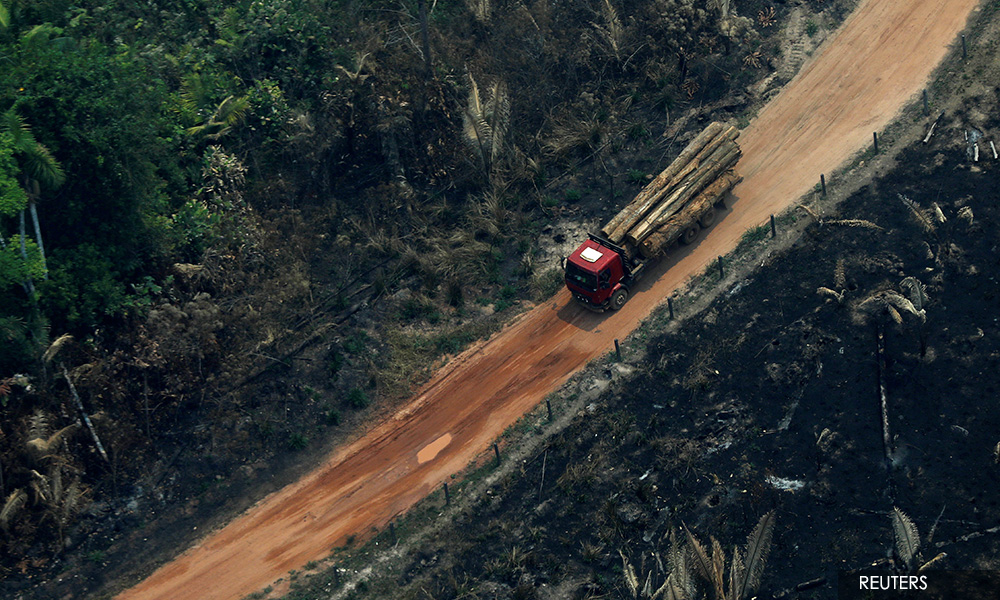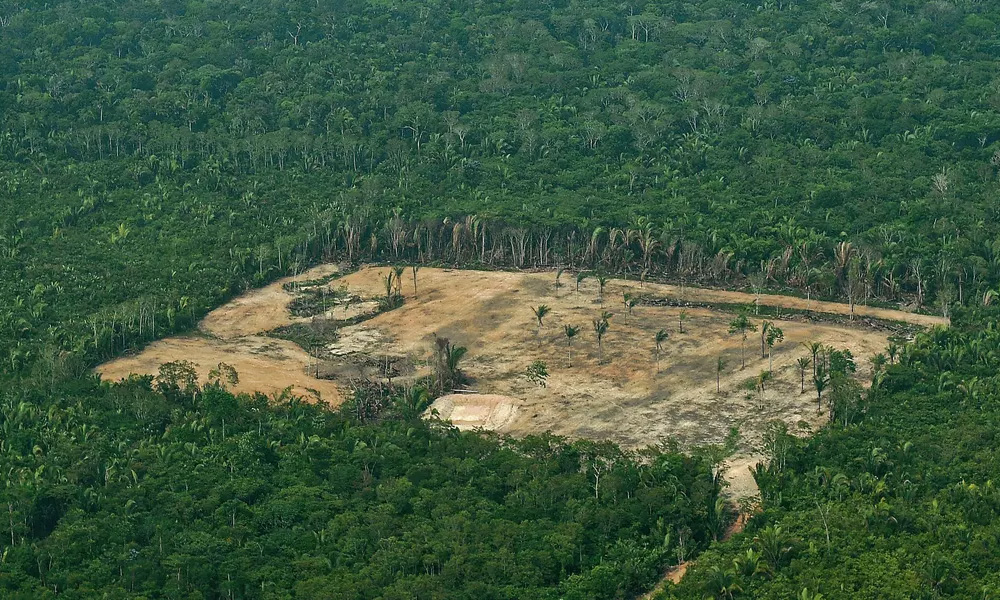Bolsonaro-backed highway targets heart of Brazil's Amazon
Deforestation in Brazil is the story of highways.
For more than 50 years, the destruction has almost always begun with a road hewn through the dense Amazon rainforest. With pavement, comes logging, then ranching and eventually commercial farming and towns.
Here in the run-down logging town of Realidade, in the state of Amazonas, ecologists say history looks set to repeat itself.
This hamlet of several dozen houses sits on the crumbling vestiges of BR-319, a highway built in the 1970s by the military and quickly abandoned. Much of the route is now impassable during the roughly six-month rainy season. Vehicles that attempt it during dry months crawl along the broken pavement, dodging epic potholes and jungle debris. Locals warn visitors who wander the section north of Realidade to look sharp for jaguars.
Now Brazil’s President Jair Bolsonaro has vowed to resuscitate the road. Some scientists say the project could determine the future of the Amazon, the world’s largest tropical rainforest.
Bolsonaro’s administration is working on an ambitious plan to begin reconstruction by 2021 as part of a broader strategy to jumpstart economic development in the region. The completed project would reconnect Realidade with Manaus, a riverfront metropolis of two million people that lies 600 kilometres to the northeast. With BR-319 out of service much of the year, Manaus is consistently reachable only by water and air travel from the rest of Brazil.

“We are certain that our BR-319 will be paved,” Bolsonaro said in July at a public event in Manaus.
Bolsonaro’s office said the president has discussed the project with Infrastructure Minister Tarcisio Freitas, but declined further comment.
Amazon researchers said the repaved road would trigger an explosion of deforestation in Amazonas, currently, Brazil’s best-preserved rainforest state precisely because it has few good roads. A highway to Manaus would enable subsistence farmers, land speculators and loggers to penetrate deep into the jungle, said Philip Fearnside, an American ecologist at Brazil’s National Institute of Amazonian Research in Manaus, who has examined the link between roads and deforestation.
A study led by the Federal University of Minas Gerais estimates the project would result in a fivefold rise in clearing by 2030, the equivalent of an area larger than the US state of Florida.
Fires have ravaged the Amazon this year, sparking a global outcry that Bolsonaro’s government is not doing enough to protect the rainforest. The president has defended his environmental policies as well as Brazil’s right to develop its territory, as industrialized nations have done with theirs. He has warned international leaders to butt out of Brazil’s internal affairs.
A leading Brazilian climate researcher, Carlos Nobre at the University of Sao Paulo, says the Amazon is nearing a tipping point, beyond which the rainforest would enter a self-sustained cycle of “dieback” as it turns into a savannah. Roughly 15-17 percent of the forest has already been destroyed and the point of no return is 20-25 percent, Nobre said.
Such a decline would release huge amounts of greenhouse gas and make it much more difficult to restrict a rise in global temperatures to 1.5-2.0 degrees Celsius, the goal to avoid the worst effects of climate change, Nobre and other scientists say.
“With BR-319, we are going to cross this tipping point, this is more than enough,” said Britaldo Soares Filho, a professor at the Federal University of Minas Gerais who has run simulations modelling the losses expected if the road is paved. “You’re opening a totally new frontier across the core of the Amazon forest,” he said.
The government says such fears are overblown. Mateus Salome do Amaral, environmental management subsecretary at Brazil’s Infrastructure Ministry, says the planned reopening of BR-319 does not portend ecological disaster.
In fact, he told Reuters, it would allow environmental agents to more easily police the area.
“Our goal isn’t to generate deforestation,” Amaral said.

Dictatorship's dream
Brazil’s former military dictatorship, fearful that its neighbours would steal its sparsely populated portion of the Amazon, built BR-319 in the 1970s to encourage Brazilians to settle the region. Nearly 900 kilometres long, the road ran from Porto Velho in western Rondonia state to Manaus in Amazonas state, considered the heart of Brazil’s Amazon.
Government interest in the road flagged with the return of democracy in 1985. By the late 1980s, most of BR-319 had disintegrated into a rutted dirt road, a reddish-brown gash through the green forest. Today the only paved sections in good repair are the 200 kilometres between Porto Velho and the city of Humaita, some 90 kilometres south of Realidade; and the 177-kilometre stretch closest to Manaus. Crude road maintenance packs down the dirt to keep the segment between Realidade and Humaita open year-round. But beyond Realidade, repairs - and civilization - largely stop.
Local residents such as Marcelo Cavalcante are thrilled by Bolsonaro’s vow to repave the route north to Manaus. Cavalcante, a used-car dealer, led a group of 17 people on a recent march on the road to generate media attention and public support for the plan.
“People came to chase the dream promised by the military government in the 1970s,” said 40-year-old Cavalcante, whose parents moved to Humaita in that era. “It’s their right to have their dream realized after so many decades.”
Bolsonaro, a former Army captain and conservative firebrand who won the election by appealing to rural interests, has moved quickly.
In February, his second month in office, his administration arranged a meeting of all relevant government agencies to coordinate efforts on repaving BR-319, according to Luiz Guilherme Rodrigues de Mello, planning director of Brazil’s transportation agency DNIT, who attended that meeting.
Mello told Reuters he expects all legally required environmental impact studies and licenses to be completed by 2021 when construction is slated to begin. That timetable would require federal legislators to approve funding next year. There is strong support for infrastructure projects among a powerful bloc of rural lawmakers in Congress.
Environmentalists and public prosecutors have used Brazil’s courts to block other projects. But they have largely resigned themselves to the prospect that BR-319 will be paved given fervent local support. Rather than fight, they say they will push for environmental preservation to be baked into the project.
The BR-319 Observatory, a coalition of six Brazilian and international nongovernmental organizations, is pressing government agencies to minimize the illegal deforestation that typically follows road projects, says Fernanda Meirelles, the group’s executive secretary.
Rafael da Silva Rocha, a federal prosecutor for Amazonas state, said his office plans to hold the government accountable for enforcing environmental laws.
“We recognize that this road will be paved at some point,” Rocha said. “It’s important that this paving happens in a sustainable way.”

Road to deforestation
Estimates vary on how rapidly Amazon deforestation would radiate from a revitalized BR-319. Earlier roads suggest possible outcomes.
One is BR-163, a vital soybean shipping route. Begun in the 1970s, the highway stretches more than 3,000 kilometres from southern Brazil to the ports of Miritituba and Santarem in the northern state of Para. The Miritituba port receives about 40,000 tonnes of soy daily from BR-163 during peak harvest season, most headed to buyers in Europe and Asia.
The road has spawned whole new Amazon cities, including Novo Progresso in Para, a frontier town of about 25,000 people settled in the early 1980s. From 2000 to 2018, about 4,500 square kilometres of rainforest around it were cleared, according to government data. That’s an area nearly three times the size of London.
Novo Progresso is among the top 10 areas for deforestation and fires in Brazil this year. Authorities are investigating a rash of blazes in August that were allegedly set by farmers.
Bolsonaro dispatched federal troops there and to other parts of the Amazon to help fight the fires. He vowed a probe to “investigate and punish those responsible” for the Novo Progresso conflagrations, Environment Minister Ricardo Salles said in August.
Still, the president has been excoriated by people in Brazil’s environmental agencies for what they see as a major rollback of protections on his watch. Nearly 700 employees of the main enforcement agency, Ibama, signed an open letter to its chief in August demanding relief for dwindling budgets and personnel.
Bolsonaro’s office declined to comment on the letter.
For some Brazilians living near BR-319, construction can’t start soon enough. Herivaneo Seixas, the mayor of Humaita, a city of 55,000 residents, said the refurbished highway would allow area farmers to speed fresh produce to Manaus, ushering in an agricultural boom.
“BR-319 is the postcard for development,” Seixas said. “Without BR-319, we’re frozen in time.”
- Reuters
RM12.50 / month
- Unlimited access to award-winning journalism
- Comment and share your opinions on all our articles
- Gift interesting stories to your friends
- Tax deductable

